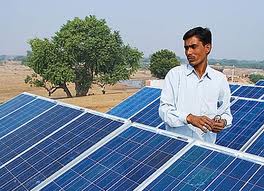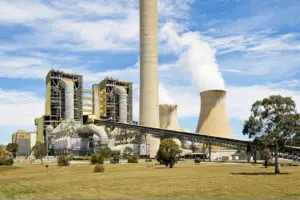Australian coal producers – in particular the billionaire miners Gina Rinehart and Clive Palmer, – face another major roadblock to their dreams of digging up the Galilee Basin and other coal-rich resources: The likely new prime minister of India is not a big fan of coal.
Narendra Modi, the leader of the Bharatiya Janata Party who is currently leading in the polls in the lead-up to the general election in May, is in fact a big fan of solar – and pioneered the first incentives for large scale solar power in 2009.
As Bloomberg writes in this profile piece, if Modi wins the election: “One thing is clear: he’s signaling a clean energy revolution to end blackouts and revive economic growth.”
Some observers suggest Modi will effectively abandon most new coal projects and turn instead to solar, potentially increasing the government’s already ambition solar targt 10-fold. Vineet Mittal, managing director of Welspun Energy, a major Indian power producer and solar developer, told Bloomberg. “I wouldn’t be surprised if he came out with a 200,000-megawatt target by 2025.”
Interestingly, Modi’s home state of Gujarat enjoys the highest take up of solar in India, 40 per cent of the country’s capacity of nearly 3,000MW, and it boasts the least blackouts in the country.
India has been hamstrung for years by its chaotic infrastructure and the inability to deliver power reliably even to big business, let alone to some 300 million people without access to the grid.
As we reported last week, when noting that BHP Billiton had insisted that coal was the only option for emerging economies, including India, the fact is that in India, energy companies, big and small, are walking away from coal-fired generation because of the costs and the risks.
Much of the country’s easy-to-access surface coal has been extracted, with the remaining reserves harder to reach: underground, beneath cities or within national parks and tiger reserve. Imported coal is too expensive.
As Associated Press reports, solar is about to cheap to build as coal, and without the headaches.
“For the first time, solar electricity prices have fallen to near parity with India’s coal-generated power prices. Subsidies at about a third of cost put solar prices at about 7 rupees (11 US cents) per kilowatt/hour, versus coal’s 5-6 rupees per kilowatt/hour. Solar projects also need fewer clearances and take just six to 12 months to develop, versus about eight years for a coal plant.
“Today’s coal availability is inadequate. And investors are worried. In India, if there are coal shortages, there will be power shortages, and industrial growth will be inhibited,” said Vivek Pandit, senior director at the Federation of Indian Chambers of Commerce and Industry.”
Modi’s solar program in Gujarat lured investment from Essar Group controlled by the billionaire brothers Shashikant and Ravikant Ruia, and SunEdison (which recently agreed to sell solar power from a 150MW power plant in Texas for less than 5c/kWh)
Bloomberg quoted S.L. Rao, the head of India’s central electricity regulator from 1998 to 2001, as saying that the utility industry in India “has reached a stage where either we change the whole system quickly or it will collapse.”
“The power sector needs tough politics, and the only person in politics today who might be capable of that kind of toughness is Modi,” he said.
Coal currently generates 68 per cent of its electricity from coal. Most of this is supplied by the state monopoly Coal India, which sell it at a 44 percent discount to global prices. However, because Coal India is unable to guarantee deliveries, companies have sought contracts overseas, but then find themselves unable to make a profit on the prices regulated in India.
Bloomberg says India is already forecast to be the sixth-largest market this year, behind China, Japan, the U.S., Germany and Italy, Bloomberg New Energy Finance estimates. Its goal to make solar PV as cheap as coal by 2022 is on track to be reached at least five years earlier, aided by a plunge in solar prices and higher costs for oil, gas and coal, according to Tarun Kapoor, the joint secretary at the Ministry of New and Renewable Energy.
As Bloomberg reports:
“We have to focus on generating more power from our abundant renewable energy resources,” Modi declared at a rally for 10,000 supporters in central Madhya Pradesh state on Feb. 26. “The time has arrived for a saffron revolution, and the color of energy is saffron.”
Invoking the three colors of the Indian flag, Modi pledged an energy overhaul that would rival the so-called green and white revolutions in the 1900s. Those turned India into a major agricultural exporter and the world’s top milk producer.
“God has showered our country with an abundance of renewable energy,” Modi told the crowd of poppy-seed farmers gathered near a sea of reflective solar panels. “If these renewable resources were exploited properly, we wouldn’t have required mining coal or spending so much on importing crude and petroleum products










